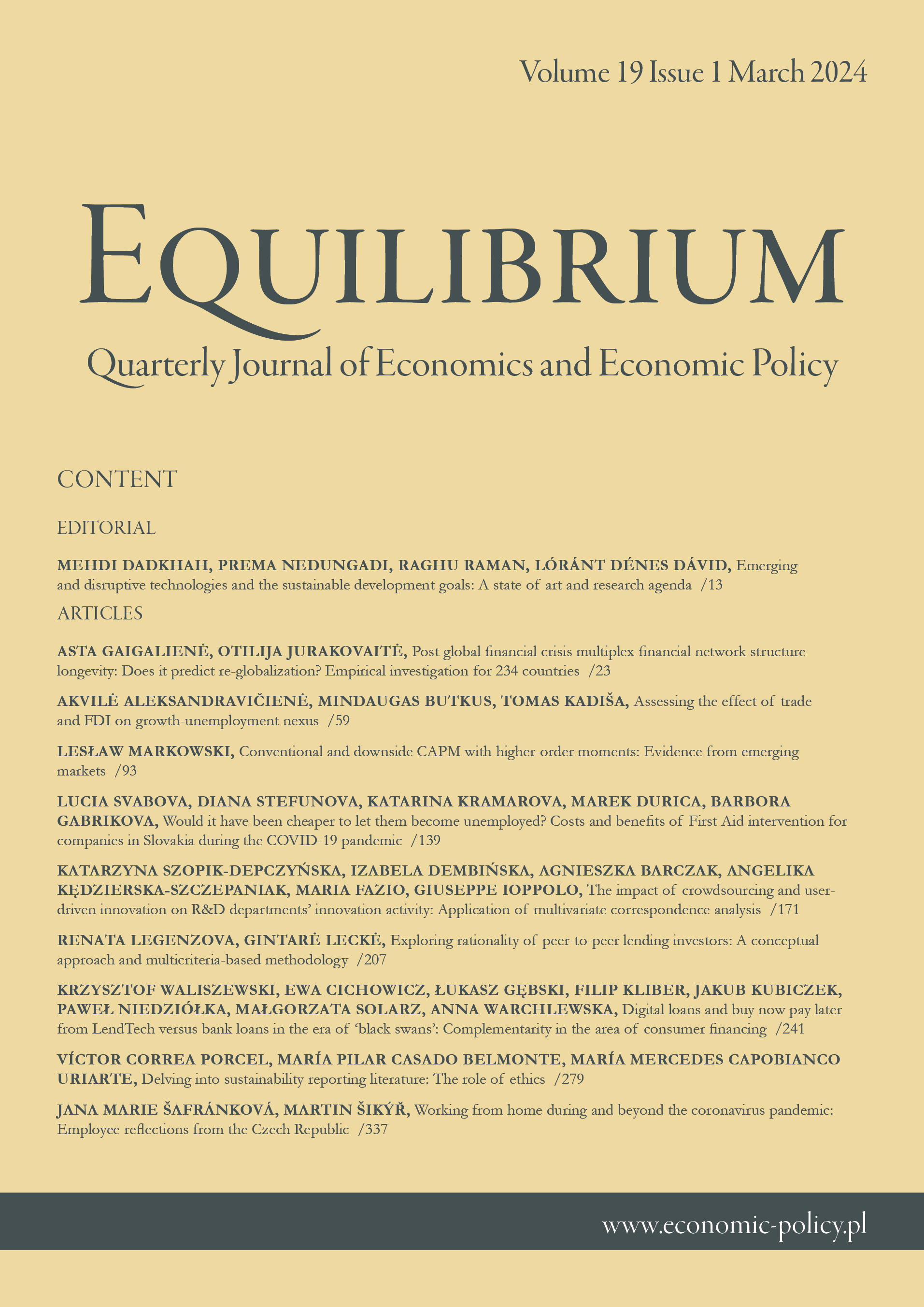How the 2020 pandemic affected tax revenues in Russian regions?
IF 5
Q1 ECONOMICS
Equilibrium-Quarterly Journal of Economics and Economic Policy
Pub Date : 2021-01-01
DOI:10.24136/eq.2021.009
引用次数: 6
Abstract
Research background: The 2020 pandemic has proven to be stressful for regional tax systems. However, these systems reacted differently to lockdown and a decline in business activity, which was associated with both their structures and the specifics of their development. Purpose of the article: The aim of the article is to assess the impact of the 2020 pandemic on tax revenues of Russian regions, as well as to analyze the factors contributing to the resilience of regional tax systems to epidemiological crises. Methods: The study is based on monthly data from the Federal Tax Service of the Russian Federation on total tax revenues in 83 Russian regions for 2013-2020. For data up to March 2020, we construct stationary time series and plotted ARiMA regressions. Based on them, we forecast tax revenues for the period from April to December 2020, if there were no pandemic. The impact of the pandemic is calculated as the deviation of actual tax revenue from the forecast for the corresponding 9 months. Findings & value added: We find that the impact of the pandemic on tax revenues varies over time and space. The crisis hit the fiscal system most negatively in the first three full months of the lockdown (April-June 2020). Some mining regions of the Urals, Western and Eastern Siberia, specializing in the extraction of oil and gas, as well as non-ferrous metals, turned out to be the most vulnerable to the pandemic. The most resistant to it are the central and southern regions of the European part of Russia. Calculation of Pearson's correlations shows that the greatest drop in tax revenues occur in regions with a larger share of the mining industry in gross value added and MET in tax revenues, with a higher GRP per capita and an increased level of general economic instability. The smallest decline in tax revenue, or even its growth, is observed in regions with a larger share of personal income tax and property tax in tax revenues, a higher share of trade and processing industries, social sphere and public administration in gross value added, a higher degree of economic diversification and a larger share of small business in total turnover. The obtained results are applicable to manage the resilience of tax systems to epidemiological crises.2020年大流行如何影响俄罗斯地区的税收收入?
研究背景:2020年的大流行已被证明对地区税收系统构成压力。然而,这些系统对封锁和商业活动下降的反应不同,这与它们的结构和发展细节有关。文章的目的:本文的目的是评估2020年大流行对俄罗斯地区税收的影响,并分析有助于地区税收制度抵御流行病学危机的因素。方法:该研究基于俄罗斯联邦税务局2013-2020年俄罗斯83个地区的月度税收总收入数据。对于截至2020年3月的数据,我们构建平稳时间序列并绘制ARiMA回归。在此基础上,我们预测了2020年4月至12月期间(如果没有大流行)的税收收入。大流行的影响按相应9个月的实际税收收入与预测的偏差计算。研究结果和增加值:我们发现,疫情对税收的影响随时间和空间而变化。在封锁的头三个月(2020年4月至6月),危机对财政体系的影响最大。乌拉尔、西伯利亚西部和东部的一些专门开采石油和天然气以及有色金属的矿区最容易受到疫情的影响。对它抵抗力最强的是俄罗斯欧洲部分的中部和南部地区。皮尔逊相关性的计算表明,税收收入下降幅度最大的地区,是采矿业在总增加值和MET在税收收入中所占份额较大的地区,人均国内生产总值较高,总体经济不稳定程度也较高。在个人所得税和财产税在税收中所占份额较大,贸易和加工业、社会领域和公共行政在总增加值中所占份额较大,经济多样化程度较高,小企业在总营业额中所占份额较大的地区,税收收入的下降甚至增长幅度最小。所得结果适用于管理税收制度对流行病危机的复原力。
本文章由计算机程序翻译,如有差异,请以英文原文为准。
求助全文
约1分钟内获得全文
求助全文
来源期刊
CiteScore
9.20
自引率
3.50%
发文量
28
审稿时长
36 weeks
期刊介绍:
Equilibrium. Quarterly Journal of Economics and Economic Policy is a scientific journal dedicated to economics, which is the result of close cooperation between the Instytut Badań Gospodarczych/Institute of Economic Research (Poland) and Polish Economic Society and leading European universities. The journal constitutes a platform for exchange of views of the scientific community, as well as reflects the current status and trends of world science and economy.
The journal especially welcome empirical articles making use of quantitative methods in: Macroeconomics and Monetary Economics, International Economics, Financial Economics and Banking, Public Economics, Business Economics, Labor and Demographic Economics, Economic Development, and Technological Change, and Growth.
Current most preferable topics and special issues:
The economics of artificial intelligence: business potentials and risks;
Digitalization and entrepreneurship in economics;
Sustainable socio-economic development, environmental and ecological economics;
Transition in the energy market (improving energy efficiency, alternative energy sources, renewable energy, energy security).

 求助内容:
求助内容: 应助结果提醒方式:
应助结果提醒方式:


